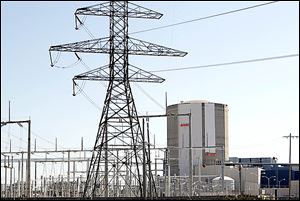
Concrete cracks no threat at Davis-Besse, NRC says
9/21/2013
Concrete samples taken from the Shield Building at the Davis-Besse nuclear power plant site have shown some degree of degradation from earlier testing, and new fissures have been discovered.
OAK HARBOR, Ohio — Concrete sampling from the Davis-Besse nuclear power plant’s Shield Building has revealed several previously undiscovered cracks and shown that three known cracks have “propagated a small amount,” FirstEnergy Nuclear Operating Corp. and the Nuclear Regulatory Commission announced Friday.
Both the utility and the agency cautioned that the discoveries do not mean the structure is unsafe, adding that the Shield Building serves as an outer shell around the plant’s reactor-containment vessel, made of carbon steel 1.5 inches thick.
FENOC reported that high-definition cameras now used for inspecting core samples from the Shield Building identified “three very tight, subsurface pre-existing cracks in the building that were not visible with previous inspection technology” as well as the three cracks that have become slightly longer than when they were first detected in 2011.
Numerous hairline cracks were discovered in the structure’s 2.5-foot concrete after a hole was cut through two years ago for access to replace Davis-Besse’s reactor head. A FirstEnergy investigation determined that the cracks were caused by wind-blown moisture that seeped into the concrete during the Blizzard of 1978 and then froze, that they had not spread since then, and that they did not compromise the building's structural integrity.
The NRC accepted a FENOC proposal to weatherproof the concrete and establish a monitoring and testing program to ensure the building, which the utility says serves the dual purpose of protecting the plant from outside incursions and backing up the reactor containment structure, remains sound.
Despite the determination that three of the cracks had spread, Ray Lieb, FirstEnergy’s site vice president for Davis-Besse, said the building is still safe.
“Analysis of all inspection results to date confirms the 2011 conclusion that the Shield Building’s structural integrity is not impacted by the presence of these tight cracks,” Mr. Lieb said in a prepared statement. “The robust building continues to function safely and reliably. Long-term, safe, reliable operation of the plant is our number one goal.”
“Based on the current information, this issue does not compromise the safety of the plant or the public,” said Viktoria Mitlyng, an NRC spokesman in Lisle, Ill. “The NRC continues to conclude that the additional cracks identified during the current inspection remain bounded by the licensee’s previous examination results, the current impact on the Shield Building, and the licensee’s extent of condition and evaluation plan.”
FENOC is in the midst of seeking a 20-year renewal of Davis-Besse’s operating license, which expires in 2017.
Michael Keegan, a spokesman for one of four anti-nuclear groups opposing the renewal, said the NRC’s continued acceptance of FirstEnergy’s studies of the Shield Building should inspire “little confidence” in the public concerning its structural integrity. “The structure is compromised,” he said Friday. “Once again, FENOC puts profit above safety.”
Contact David Patch at: dpatch@theblade.com or 419-724-6094.